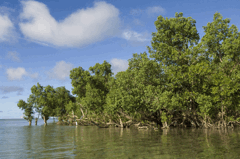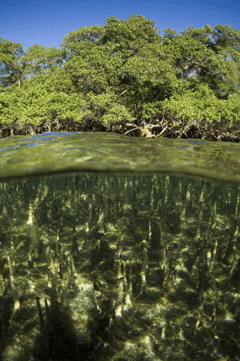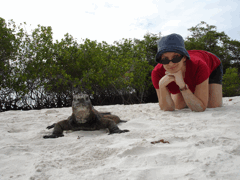Coastal Carbon Sink
Air Date: Week of November 20, 2009

Mangrove coastal marine habitat (Courtesy of Conservation International.)
Coastal marine environments like mangroves and seagrass meadows capture carbon from the air and use their long root systems to bury it deep within the soil. Host Jeff Young talks with Emily Pidgeon, the director of the Marine Climate Change Program at Conservation International. Dr. Pidgeon speaks about a recent report that demonstrates how these coastal marine areas are 50 percent more efficient at burying carbon than tropical forests.
Transcript
YOUNG: The takeaway message from Professor Khatiwala’s study, of course, is that we need to reduce our greenhouse gas emissions. Another report also suggests ways we can help the oceans help us with our carbon debt. The International Union for the Conservation of Nature asked scientists to focus on the role of coastal ecosystems in the carbon cycle. Conservation International oceanographer Emily Pidgeon found these relatively small parts of the planet have a huge capacity to soak up CO2.
PIDGEON: There were three main systems that we looked at in this report that seemed to be able to sequester large amounts of carbon. And they are tidal salt marshes that are found all around the world. In the US we see them all the way along the Atlantic coast and in the Gulf of Mexico. Mangroves – which are sort of a very dominant part of any tropical or sub-tropical coastline. And then sea grasses, which occur globally – we see them a lot in the Caribbean including Florida and throughout the Mediterranean and many other places.

Mangrove coastal marine habitat “Courtesy of Conservation International.)
YOUNG: Now, I think we all know that these are pretty important ecosystems, but why are they important in terms of the carbon cycle?
PIDGEON: Well, all plants, whether they be on land or in the ocean sequester carbon in a number of different ways. The one that we perhaps are more familiar with is absorbing the carbon and using it to grow. So, then the carbon is stored in the actual plant, itself. Whether it be the large trunk of an enormous tree in the Amazon forest or in the leaves of a small sea grass. But, the other way that plants also sequester carbon is by burying it in the soil or the sediment below them. And these marine plants, or marine ecosystems, seem to be incredibly effective at the second type of carbon sequestration. This burying it in the sediment below them.
YOUNG: Why is that?
PIDGEON: There’s a couple different ways they do it. The two main ones are they have these incredibly deep root systems. If you can imagine they’re all living in the sort of tidal or wave dominated part of the coast and they’re holding on for dear life with these deep root systems. And it’s through this deep root systems that they can pull carbon out of either the water or the air and then pump it down in to the sediment and push it out. There is also these areas that are really good for capturing sediment that is in the shallow water, and by doing that that settles down and also captures lot of carbon that way.

Mangrove coastal marine habitat (Courtesy of Conservation International.)
YOUNG: Okay, so give me a sense of scale here – how do these marine ecosystems measure up as a carbon sink compared to the ones we’re more familiar with; let’s say, forests?
PIDGEON: Well, because these areas are so small compared to those forests. If you think about their actual storage in the plant – they’re probably not that large in terms of carbon storage, compared to tropical forests. But then when we get to look at this sequestration ability, this ability to bury it in the sediment below them, which can be up to 50 times more efficient than the tropical forests. Then you begin to see the fact that these areas are really very important. Sea grasses bury the carbon literally meters into the ground and it can stay there for centuries and millennia. Whereas the tropical forests really just aren’t as efficient at burying the carbon into the soil below them.
YOUNG: Boy, we sure aren’t very grateful in the way we treat them – we’re destroying these areas like crazy, aren’t we?
PIDGEON: Yes, that’s very true. And we have been doing so for a very long time. All these coastal areas have really suffered from all sorts of coastal development, whether it be draining salt marshes to build cities and towns. Whether it be building large port facilities, or just clearing mangroves because we’d prefer to look at the beach and the water than actually just mangrove forest areas. We’re losing these areas significantly.
YOUNG: So, going back to looking at them through the lens of their place in the carbon cycle, and their ability to sock away carbon. What are we losing when we lose those mangroves?

Photo of Dr. Emily Pidgeon.(Courtesy of Conservation International.)
PIDGEON: The mangroves, the number that is being used at the moment is that 20 percent of the total mangrove coverage has been lost since 1980. This is the equivalent of losing about 6,000 or nearly 7,000 square kilometers of tropical forest in sequestration capacity, into the soil. So, if we look at mangroves and sea grasses together. The losses we see for each of those habitat types – we’re losing carbon sequestration capacity at almost the same rate that we are losing tropical forests from the Amazon. It really just underlines that we need to be protecting these coastal systems, worldwide.
In the US, they’re very important for fisheries and for coastal protection. And in many parts of the developing world, in Southeast Asia for instance, these coastal systems provide livelihood and food for entire communities. They’re also very important for allowing people to start to cope with the impacts of climate change. Whether that be sea level rise or increased storms. Marshes, mangroves and sea grasses help protect them against increasing erosion, and against inundation. And so this is really just underlining that we need to be really re-doubling our efforts at protecting these systems.
YOUNG: Emily Pidgeon with Conservation International. Thanks so much for your time.
PIDGEON: Thank you.
Links
To read the IUCN report click here
Living on Earth wants to hear from you!
Living on Earth
62 Calef Highway, Suite 212
Lee, NH 03861
Telephone: 617-287-4121
E-mail: comments@loe.org
Newsletter [Click here]
Donate to Living on Earth!
Living on Earth is an independent media program and relies entirely on contributions from listeners and institutions supporting public service. Please donate now to preserve an independent environmental voice.
NewsletterLiving on Earth offers a weekly delivery of the show's rundown to your mailbox. Sign up for our newsletter today!
 Sailors For The Sea: Be the change you want to sea.
Sailors For The Sea: Be the change you want to sea.
 The Grantham Foundation for the Protection of the Environment: Committed to protecting and improving the health of the global environment.
The Grantham Foundation for the Protection of the Environment: Committed to protecting and improving the health of the global environment.
 Contribute to Living on Earth and receive, as our gift to you, an archival print of one of Mark Seth Lender's extraordinary wildlife photographs. Follow the link to see Mark's current collection of photographs.
Contribute to Living on Earth and receive, as our gift to you, an archival print of one of Mark Seth Lender's extraordinary wildlife photographs. Follow the link to see Mark's current collection of photographs.
 Buy a signed copy of Mark Seth Lender's book Smeagull the Seagull & support Living on Earth
Buy a signed copy of Mark Seth Lender's book Smeagull the Seagull & support Living on Earth

